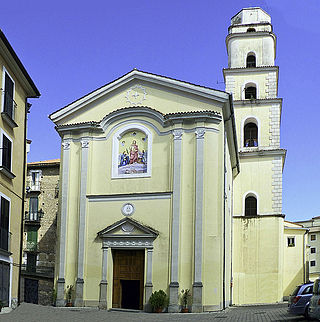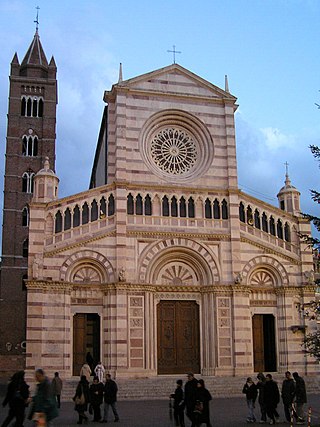Related Research Articles

The Diocese of Nola is a Latin diocese of the Catholic Church in Italy, suffragan of the Archdiocese of Naples. Its seat is the Campanian city of Nola, now a suburb of Naples. Its cathedral is dedicated to the Assumption. The dedication was originally to S. Stephen, the Protomartyr, but after the second reconstruction the dedication was changed to the Assumption. It is traditionally credited with the introduction of the use of bells into Christian worship.

The Archdiocese of Capua is a Latin diocese of the Catholic Church in Capua, in Campania, Italy, but its archbishop no longer holds metropolitan rank and has no ecclesiastical province. Since 1979, it is a suffragan of the Archdiocese of Napoli, i.e. no longer has its own ecclesiastical province nor metropolitan status.

The Archdiocese of Gaeta is a Latin Church ecclesiastical territory or archdiocese of the Catholic Church in southern Italy, in the city of Gaeta, in the Lazio region. The archbishop's cathedra is located in the Cathedral of SS. Erasmus and Marcianus and the Assumption of the Virgin Mary in the episcopal see of Gaeta. A non-metropolitan see, the archdiocese is immediately exempt to the Holy See.

The Roman Catholic diocese of Ferentino existed until 1986, when it was united into the new diocese of Frosinone-Veroli-Ferentino.

The Diocese of Vallo della Lucania is a Latin Church diocese of the Catholic Church in Campania, has existed under this name since 1945. It is a suffragan of the Archdiocese of Salerno-Campagna-Acerno.

The Archdiocese of Reggio Calabria-Bova is a Latin Church ecclesiastical territory or diocese of the Catholic Church in Calabria, southern Italy. It received its current title in 1986, when the independent Diocese of Bova was suppressed, and the territory and title of the diocese added to that of the Archdiocese of Reggio.

The diocese of Cervia was a Roman Catholic diocese in Emilia-Romagna. The diocese was a suffragan of the Archdiocese of Ravenna. In 1947 it merged with the archdiocese of Ravenna to form the Archdiocese of Ravenna-Cervia.

The Diocese of Grosseto is a Latin Church diocese of the Catholic Church in Italy, a suffragan of the archdiocese of Siena-Colle di Val d'Elsa-Montalcino, in Tuscany. Its current bishop is Giovanni Roncari, OFMCap.

The Diocese of Nocera Umbra was a Catholic diocese in Umbria, Italy.

The Diocese of Treviso is Latin Church ecclesiastical territory or diocese of the Catholic Church in the Veneto, Italy. It is a suffragan diocese in the ecclesiastical province of the metropolitan Patriarchate of Venice.
The Italian Catholic diocese of Bertinoro existed from 1360 to 1986. In that year it was merged with the diocese of Forlì to create the diocese of Forlì-Bertinoro.

The Diocese of Cesena-Sarsina is a Latin diocese of the Catholic Church in Emilia Romagna was created on September 30, 1986, after the Diocese of Sarsina was united with the historic Diocese of Cesena as a suffragan of the Archdiocese of Ravenna-Cervia.

The Diocese of Conversano-Monopoli is a Latin diocese of the Catholic Church in Apulia. It has existed since 1986, when the diocese of Monopoli was united with the historic diocese of Conversano. The diocese is a suffragan of the Archdiocese of Bari-Bitonto.

The diocese of Teano-Calvi is a Latin diocese of the Catholic Church in Campania, southern Italy, created in 1986. It is a suffragan of the Archdiocese of Naples. The historic Diocese of Teano and diocese of Calvi Risorta were united in 1818, forming the diocese of Calvi e Teano.

The Diocese of Trieste is a Latin diocese of the Catholic Church in the Triveneto. It has existed since no later than 524, and in its current form since 1977. The bishop's seat is in the Cathedral Basilica of Saint Justus Martyr. It is a suffragan of the Archdiocese of Gorizia.

The Diocese of Latina-Terracina-Sezze-Priverno is a Latin Church ecclesiastical territory or diocese of the Catholic Church in Lazio, Italy. It was established under this name in 1986. It is the continuation of the Diocese of Terracina, Priverno e Sezze, whose existence was confirmed by Pope Honorius III in 1217, as a joining of the Diocese of Terracina with the Diocese of Priverno and the Diocese of Sezze under a single bishop. It is immediately exempt to the Holy See.

The Diocese of Sessa Aurunca is a Latin diocese of the Catholic Church in southern Italy. Since 1979 it has been a suffragan of the Archdiocese of Naples.

The Archdiocese of Catanzaro-Squillace is a Latin Church diocese of the Catholic Church in Calabria, has existed in its current form since 1986. In that year the Archdiocese of Catanzaro became a metropolitan see, and was combined with the diocese of Squillace.

The former Italian Catholic Diocese of Chiusi-Pienza, in Tuscany, existed until 1986. In that year it was united into the Diocese of Montepulciano-Chiusi-Pienza. The Diocese of Chiusi (Clusinus) was at first immediately subject to the Holy See, but was made a suffragan of archdiocese of Siena by Pope Pius II. From 1459 to 1986, it was a suffragan of the archdiocese of Siena.

The Diocese of Montalcino was a Roman Catholic diocese located in the town of Montalcino to the west of Pienza, close to the Crete Senesi in Val d'Orcia in Tuscany, Italy. In 1986, it was suppressed and united with the Diocese of Colle di Val d'Elsa and the Archdiocese of Siena to form the Archdiocese of Siena-Colle di Val d'Elsa-Montalcino.
References
- ↑ Umberto Benigni (1908). "Diocese of Calvi and Teano". In: The Catholic Encyclopedia. New York: Robert Appleton Company. Retrieved: 11 October 2019.
- ↑ Bullarii Romani continuatio, Summorum Pontificum Clementis XIII, Clementis XIV, Pii VI, Pii VII, Leonis XII Gregorii XVI constitutiones... (in Latin). Vol. Tomus decimus quintus (15). Rome: typographia Reverendae Camerae Apostolicae. 1853. pp. 9, 57 § 6.
- ↑ Acta Apostolicae Sedis 79 (Città del Vaticano 1987), pp. 674-676.
- ↑ According to his hagiographical Life, Paris of Athens was the first bishop of Teano, and he was consecrated by Pope Sylvester I (314–335). He killed a dragon, which the citizens of Teano kept; he was therefore put in prison and condemned to be eaten by a bear; but the bear humbly licked him, and people were converted to Christianity. He died c. 346. Ughelli, p. 589. Lanzoni, p. 186, no. 1: "I citati documenti agiografici, che ne fanno menzione, possono risalire al vi secolo." Kehr, p. 255, points out that Paris is not commemorated in the martyrologies until the 16th century: "Sed acta eius ex lectionario quodam Teanensis ecclesiae hausta recentiora certe sunt; neque enim. s. Paris commemoratur in martyrologiis generalibus ante saec. XVI.'
- ↑ According to his hagiographical Life, Amasius, a Greek who was fleeing the persecution of the Emperor Constantius, was the second bishop of Teano, and he was consecrated by Pope Julius I (337–352) in Rome in the Basilica of the XII Apostles. The Basilica, however, was built by Pope Pelagius I in the 6th century. Amasius died after 355. Ughelli, pp. 589-591. Cappelletti, pp. 197-198 (who places his death on 23 January 356). Lanzoni, p. 186, no. 2.
- ↑ Urbanus, a native of Teano, had been the disciple and deacon of Bishop Amasius. He had been selected as bishop before Amasius, but he refused at the time. It is said that he visited many places in his dioceses and restored the dilapidated churches, revivifying the faith of the people. Ughelli, pp. 551. Cappelletti, p. 198. Lanzoni, p. 186, no. 3.
- ↑ Quintus attended the first Roman synod of Pope Symmachus in 499. J. D. Mansi (ed.), Sacrorum Conciloiorum nova et amplissima collectio, editio novissima, Tomus VIII (Florence: A. Zatta 1762), p. 235. Lanzoni, p. 186, no. 4.
- ↑ Pope Pelagius I sent a mandate to Bishop Domninus: Paul Fridolin Kehr, Italia pontificia VIII: Regnum Normannorum—Campania(Berlin: Weidmann 1935), p. 256 no. 2.
- ↑ The name MAVRVS EP appears on a fragment of a dedication. There is no mention of his diocese. Cappelletti, pp. 198-199.
- ↑ Bishop Lupus (or Lupoaldus) is mentioned in Leo the Deacon, Chronicon Casinense, Book I, chapter 32. Ughelli, p. 551. Cappelletti, p. 199.
- ↑ Bishop Hilarius had been a monk of Montecassino and a deacon, and was the immediate successor of Bishop Lupus. He consecrated a church for the Bishop of Capua in 867. Leo Marsicanus (1854). "Leonis Marsicani et Petri Diaconi, monachorum Casinensium" chronicon monasterii Casinensis et opuscula. Patrologiae Latinae Tomus CLXXIII (in Latin). Paris: Migne. p. 985. Cappelletti, p. 199.
- ↑ Leo Marsicanus (1854). "Leonis Marsicani et Petri Diaconi, monachorum Casinensium" chronicon monasterii Casinensis et opuscula. Patrologiae Latinae Tomus CLXXIII (in Latin). Paris: Migne. p. 539. Ughelli, p. 551. Cappelletti, p. 199.
- ↑ In 879, Pope John VIII wrote to Bishop Leo, in reply to his letter, about disorders in Campania over the election, confirmation, and installation of an archbishop. Pope Stephen V also wrote to Bishop Leo, in 887 or 888. Ughelli, p. 389. Kehr, p. 256 no. 3 and 5.
- ↑ Angelarius had been a monk, Provost, and the 20th Abbot of Montecassino. He died on 5 December 889, according to Ughelli, p. 551-552. Cappelletti, p. 200.
- ↑ Cappelletti, p. 200.
- ↑ Pope John XVIII wrote to Bishop Sandarius (or Landoarius) determining parish boundaries. Cappelletti, p. 200. Kehr, p. 256, no. 6. The parish boundaries were confirmed by Pope Paschal II.
- ↑ Arduinus was present at the Roman synod of Pope Nicholas II in 1059. Ughelli, p. 552.
- ↑ Pope Calixtus II wrote to Pandulfus, asking him to influence Raonis to return property belonging to Monte Cassino. Kehr, p. 256 no. 8.
- ↑ Pope Hadrian IV appointed two cardinals to settle a dispute in which Bishop Petrus was involved. Bishop Petrus was present at the Lateran Council of 1179. Petrus received a mandate from Pope Alexander III in 1180. Kehr, p. 257 no. 9 and 13.
- ↑ Gams, p. 930. Pope Celestine III confirmed the boundaries of the diocese in a bull addressed to Bishop Theodinus on 29 September 1193. In 1197 Celestine III ordered the Archbishop of Naples to settle a dispute involving Bishop Peter; the settlement was ratified on 4 January 1197. Kehr, p. 258 no. 20; 259 no. 21. Eubel, Hierarchia catholica I, p. 480.
- ↑ Roffredus died on 23 October 1239. Eubel I, p. 480.
- ↑ Eubel I, p. 480.
- ↑ Bishop Bartholomaeus was transferred to the diocese of Chieti. Eubel I, p. 480.
- ↑ Marinus was transferred to Amalfi. Eubel, I, pp. 480–481.
- ↑ Eubel, I, pp. 481 and 418. It appears that Bishop Thomas followed the Avignon Obedience and was replaced by Urban VI of the Roman Obedience with Bishop Jordanus. (transferred to Reggio)
- ↑ Gasparus was only twenty-two when appointed by the deposed Gregory XII, too young to be consecrated a bishop. Eubel I, p. 481.
- ↑ Eubel II, p. 249.
- ↑ In 1469 Fortiguerra resigned the abbacy of S. Basilio de Cavata in the diocese of Parma, and in 1477 the monastery of S. Bartolommeo in the diocese of Ferrara. Nicolaus Fortiguerra was named a cardinal by Pope Pius II in his first Consistory on 5 March 1460. He died on 21 December 1473. Eubel II, p. 249.
- ↑ Orsini had been Bishop of Tricarico from 1471 to 1474. Eubel II, p. 255.